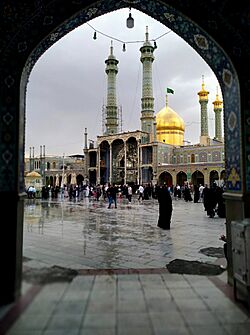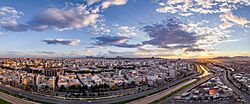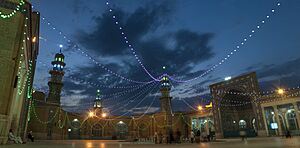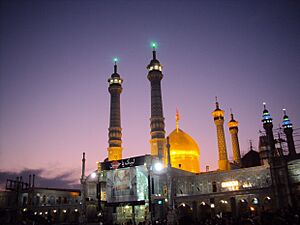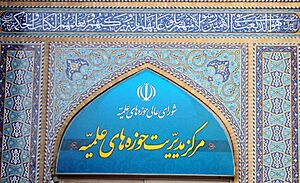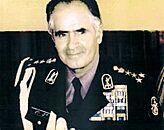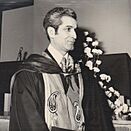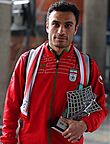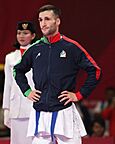Qom facts for kids
Quick facts for kids
Qom
قم
|
||
|---|---|---|
|
City
|
||
|
کلانشهر قم · Qom Metropolis
|
||
|
Top: Fatima Masumeh Shrine, Second Row: Left: Bagh-e Gonbad-e Sabz Right: Grand Timcheh of Qom, Third Row: Left: Feyziyeh Madrasas Right: Qom Jamkaran Mosque, Bottom: Panoramic view of downtown Qom
|
||
|
||
| Country | Iran | |
| Province | Qom | |
| County | Qom | |
| District | Central | |
| Elevation | 936 m (3,071 ft) | |
| Population
(2016)
|
||
| • City | 1,201,158 | |
| • Metro | 1,260,000 | |
| • Population Rank in Iran | 7th | |
| Time zone | UTC+3:30 (IRST) | |
| Postal code |
37100
|
|
| Area code(s) | (+98) 025 | |
| Climate | BWh | |
Qom (Persian: قم) is a big city in Iran. It is the capital of Qom Province. Qom is about 140 kilometers (87 miles) south of Tehran, Iran's capital. It sits on the banks of the Qom River.
This city is very important in Shi'a Islam. It is home to the shrine of Fatimah bint Musa. She was the sister of Imam Ali ibn Musa Rida, a very respected figure. Qom is the biggest center for Shi'a religious learning in the world. Millions of pilgrims visit the city every year. Most are Iranians, but many other Shi'a Muslims come from all over the world.
Qom is also a busy industrial city. It is close to Tehran, which helps its economy. The city is a key place for moving oil and gas products. Oil was found near Qom in 1956, which brought more wealth to the area. A large oil refinery was built between Qom and Tehran.
Contents
- What's in a Name? The Meaning of Qom
- A Journey Through Time: Qom's History
- People and Population
- Where is Qom? Geography and Climate
- How Qom is Governed
- Visiting Qom: Tourism and Culture
- Learning in Qom: Educational Institutions
- Getting Around Qom: Transportation
- Famous People from Qom
- Sister Cities: Qom's International Connections
- Images for kids
- See also
What's in a Name? The Meaning of Qom
Some experts believe the word "Kom" in old names like "Komidan" meant "city." They think "Komiran" was an older name for Qom. This name might be linked to other city names in Iran, like "Tehran."
A Journey Through Time: Qom's History
The city of Qom has a very long history. People have lived in this area for thousands of years. Early digs show that people settled here a long time ago. There are also old ruins from the Parthian and Seleucid times. One famous ruin is Khurha, southwest of Qom. Its purpose is still debated by historians.
Qom in Ancient Persia
During the Sasanian period, Qom was a small administrative center. Many old buildings and fire temples existed then. Some sources say the first Sasanian king, Ardashir I, fought important battles near Qom. This shows the area's importance even back then.
The Arrival of Arabs
The Arab conquest of Qom happened around 644 AD. Later, in the late 600s, a group of Ashaari Arabs settled in Qom. They came from Kufa and slowly bought land. They became very powerful in the region.
A Holy City Emerges
A very important event for Qom was the death of Fātimah bint Mūsā in 816-817 AD. She was the sister of the eighth Shi'a Imam. Her burial place grew into a magnificent shrine. This shrine made Qom a major pilgrimage site.
Challenges and Changes
Qom faced many challenges over the centuries. There were rebellions against taxes and conflicts with different rulers. The city was attacked by Turkish military leaders. Despite this, Qom grew as a center for Shi'a learning. Many important Shi'a scholars lived there.
Life in 10th Century Qom
By the 10th century, Qom was a mix of six original villages. The main center was Mamajjān. Bridges connected parts of the city across the river. There were mosques, a bazaar, and bathhouses. The city had good roads and gates.
However, Qom also faced economic problems. Many buildings were ruined, and farming suffered. This was due to high taxes and unstable times. The water supply system, managed by the Ashaaries, also declined.
Under Different Empires
Qom came under the rule of different empires, like the Seljuks and Buyids. The Seljuks, who were mostly Sunni, still had good relations with Qom's Shi'a leaders. Many religious buildings and schools were built during this time.
Mongol Invasion and Recovery
In 1224, the Mongol armies completely destroyed Qom. The city was in ruins for about 20 years. But slowly, it began to rebuild. Wealthy people helped repair the shrines of Shi'a saints. The city walls were likely rebuilt too.
Qom in Recent Times
In the late 1300s, Tamerlane plundered Qom. But during the Safavid dynasty, Qom grew again because of its religious shrine. It became a key center for Shi'a theology and pilgrimage by 1503.
The city suffered more damage during Afghan invasions and conflicts between ruling families. In 1793, Agha Muhammad Khan Qajar took control. Later, Fath Ali Shah Qajar helped repair the holy shrine.
Qom saw new growth in the Qajar era. In 1915, some people even thought about moving Iran's capital from Tehran to Qom. This idea did not happen. In the 20th century, Qom's religious learning center saw a big comeback. This was thanks to Shaykh Abdul Karim Haeri Yazdi.
More recently, in 1964-65, Ayatollah Khomeini led his opposition to the Pahlavi dynasty from Qom. In 2020, the first cases of COVID-19 in Iran were found in Qom.
People and Population
How Many People Live in Qom?
Qom's population has grown a lot over the years.
- In 2006, about 957,496 people lived there.
- By 2011, the population was 1,074,036.
- In 2016, it reached 1,201,158 people.
Qom is a major center for Shi'a Muslims. Since the Iranian Revolution, the number of religious scholars has increased greatly. Many religious schools and research centers are in Qom. The city is home to the Fatima Masumeh Shrine and the Jamkaran Mosque, both very popular pilgrimage sites.
Where is Qom? Geography and Climate
Qom is located in a low plain, about 125 kilometers (78 miles) south of Tehran. It is on the edge of Iran's central desert.
Qom's Weather: Hot and Dry
Qom has a hot desert climate. This means it gets very little rain each year. Summers are very hot and dry. Winters can be warm, but sometimes they get very cold. The coldest temperature ever recorded was -23°C (-9°F) in January 2008. The hottest was 47°C (117°F) in July 2010.
| Climate data for Qom (1986–2010, records 1986–2020) | |||||||||||||
|---|---|---|---|---|---|---|---|---|---|---|---|---|---|
| Month | Jan | Feb | Mar | Apr | May | Jun | Jul | Aug | Sep | Oct | Nov | Dec | Year |
| Record high °C (°F) | 23.4 (74.1) |
26.5 (79.7) |
35.5 (95.9) |
37.0 (98.6) |
41.8 (107.2) |
45.9 (114.6) |
47.0 (116.6) |
45.6 (114.1) |
42.3 (108.1) |
37.7 (99.9) |
31.0 (87.8) |
22.5 (72.5) |
47.0 (116.6) |
| Mean daily maximum °C (°F) | 10.2 (50.4) |
13.6 (56.5) |
19.1 (66.4) |
26.0 (78.8) |
31.8 (89.2) |
37.9 (100.2) |
40.3 (104.5) |
39.4 (102.9) |
34.9 (94.8) |
27.7 (81.9) |
18.9 (66.0) |
12.2 (54.0) |
26.0 (78.8) |
| Daily mean °C (°F) | 4.2 (39.6) |
7.1 (44.8) |
12.0 (53.6) |
18.3 (64.9) |
23.6 (74.5) |
29.1 (84.4) |
31.8 (89.2) |
30.3 (86.5) |
25.2 (77.4) |
19.0 (66.2) |
11.5 (52.7) |
6.1 (43.0) |
18.2 (64.8) |
| Mean daily minimum °C (°F) | −1.9 (28.6) |
0.6 (33.1) |
5.0 (41.0) |
10.5 (50.9) |
15.4 (59.7) |
20.2 (68.4) |
23.4 (74.1) |
21.2 (70.2) |
15.6 (60.1) |
10.3 (50.5) |
4.1 (39.4) |
−0.1 (31.8) |
10.4 (50.7) |
| Record low °C (°F) | −23.0 (−9.4) |
−11.2 (11.8) |
−11.0 (12.2) |
−0.2 (31.6) |
5.4 (41.7) |
8.0 (46.4) |
15.0 (59.0) |
11.8 (53.2) |
6.5 (43.7) |
0.6 (33.1) |
−11.0 (12.2) |
−10.5 (13.1) |
−23.0 (−9.4) |
| Average precipitation mm (inches) | 25.4 (1.00) |
20.5 (0.81) |
27.7 (1.09) |
20.2 (0.80) |
10.4 (0.41) |
2.3 (0.09) |
0.7 (0.03) |
0.3 (0.01) |
0.8 (0.03) |
6.2 (0.24) |
14.3 (0.56) |
19.4 (0.76) |
148.2 (5.83) |
| Average precipitation days (≥ 1.0 mm) | 4.4 | 4.1 | 4.2 | 3.9 | 2.0 | 0.4 | 0.2 | 0.1 | 0.3 | 1.8 | 2.6 | 3.2 | 27.2 |
| Average snowy days | 3.1 | 1.4 | 0.3 | 0.0 | 0.0 | 0.0 | 0.0 | 0.0 | 0.0 | 0.0 | 0.1 | 0.9 | 5.8 |
| Average relative humidity (%) | 66 | 58 | 48 | 42 | 33 | 24 | 23 | 24 | 26 | 38 | 52 | 66 | 41 |
| Mean monthly sunshine hours | 185.0 | 194.0 | 221.5 | 233.3 | 296.6 | 351.5 | 354.5 | 347.3 | 309.9 | 263.4 | 204.9 | 172.7 | 3,134.6 |
| Source: Iran Meteorological Organization (records), (temperatures), (precipitation), (humidity), (days with precipitation and snow), (sunshine) | |||||||||||||
How Qom is Governed
The city of Qom is led by a mayor. The mayor is chosen by a municipal board. The people living in Qom elect this board. The main office for the city's government is on Saheli Street.
Neighborhoods of Qom
Qom has many different neighborhoods. Some are older, and some are more modern.
Old Districts
- Soltan Mohammad Sharif
- Bagh Pambeh
- Jouy Shour
- Safaiyyeh
- Sadough
- Yakhchal Ghazi
- Shah Ahmad Ghasim
- Bagh Ashrafi
- Darvaze Ghale'
- Khandagh
- Ghale Amou Hossein
- Barassoun
- Hammam Taalaar
- Sang Band
- Eshgh Ali
- Tekyeh Agha Sayyed Hassan
- Arabestan
- Darvazeh Kashan
- Sarbakhsh
- Sar Howz
- Alvandiyeh
- Gozar Sadegh
- Lab Chaal
- Chehel Akhtaran
- Razavia
- Manba' Ab
- Nikouyee
- Nowbahar
- Allouchou
- Khak-Faraj
- Haj Zaynal
- Haj Khalil
- Bagh Shazdeh
- Chehel Derakht
- Zad
- Chahar Imamzadeh
- Hanif Nizhad
- Paminar
- Qom Now
- Maydan Now
- Zandyan va Handyan
- Darvazeh Choubi
Modern Districts
- Tohid
- Shahr-e-Gha'em
- Panzdah-e-Khordad
- Jahan Bini
- Talighani Town
- Baajak Town
- Farhangian Town
- Tavaneer Town
- Fatimia Town
- Imam Hassan Town
- Imam Hossein Residential Area
- Bonyad Residential Area
- Mahdia Town
- Imam Khomeini Town
- Pardisan City
- Safa Shahr
- Qods Town
Visiting Qom: Tourism and Culture
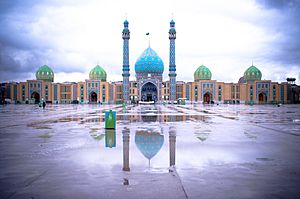
Qom has many interesting historical and cultural places to visit. Iran's Cultural Heritage Organization lists 195 such sites!
Popular Places to See
- Shrine of Fatimah al-Masumah: This is the most important religious site.
- Jamkaran Mosque: Another very popular religious place.
- Azam Mosque: A large and impressive mosque.
- Qom Bazaar: A traditional market where you can find many things.
- Feyzieh Religious School: An old and famous religious school.
- Mar'ashi Najafi Library: A huge library with many old handwritten books.
- Timcheh-ye-Bozorg (Grand Timcheh): A historic and grand building.
- Gonbad Sabz Historical Garden: A beautiful garden with old tombs.
- Ruhollah Khomeini's House: The former home of a very important religious leader.
Museums to Explore
- Astaneh Moqaddaseh Museum (Qom Central Museum): Learn about Qom's history and culture.
- Anthropology Museum Of Qom: Discover the human history of the region.
- The Museum Of Traditional Arts: See local art and crafts.
- The Museum Of Natural History & Wildlife: Explore nature and animals.
- The Museum Of Astronomy: Learn about stars and space.
Learning in Qom: Educational Institutions
Qom is famous for its many religious schools, called seminaries. These schools offer advanced religious studies. This makes Qom the biggest center for Shi'a scholarship in the world. About 50,000 students from 80 countries study here. There are also seminaries for women. Many schools teach modern subjects alongside religious studies.
Qom Seminary (Hawzah 'Ilmiyya Qom)
The Hawzah is a large network of over 200 education and research centers. It serves more than 40,000 scholars and students. The modern Qom Hawzah was revived about a century ago.
Universities and Seminaries in Qom
- University of Qom
- Mofid University
- Qom University of Medical Sciences
- Al-Mustafa International University
- Qom University of Technology
- Al-Zahra Seminary (for women)
- Seyyed Hassan Shirazi Seminary
- Imam Hossein Seminary
- Imam Baghir Seminary
- Imam Mahdi Seminary
- Rasoul A'zam Seminary
- Razavia Seminary
- Satia Seminary
- Imam Khomeini Seminary
- Aba-Salih Seminary
- Al-Mahdi Seminary
- Al-Hadi Seminary
- Haghani Seminary
- Janbazan Seminary
- Resalat Seminary
- Itrat Seminary
- Darb-Astana Seminary
- Seyyed Abdol Aziz Seminary
- Toloo-e-Mehr Educational Institute
- Shahab Danesh University
- Pardis-e-Daneshgah-e-Tehran University
- IRIB University Of Qom
- Qom's Industrial College
- Azad Islami University of Pardisan
- Payam-Nour College of Pardisan
- Ma'sumia University
- Hikmat College
- The University Of Religions & Denominations
- Quran & Hadis University
- Fekr-e-Eslami University
- Ma'aref-e-Islami University
- Computer Research Center of Islamic Sciences
Getting Around Qom: Transportation
Qom has many streets and roads for getting around. A new airport, Qom International Airport, is being built to serve the city.
Famous People from Qom
Many notable people have come from Qom. Here are a few:
- Hasan-i Sabbah (1050-1124) - A historical leader.
- Gholam Ali Oveissi (1918–1984) – A general and military commander.
- Farrokhroo Parsa (1922–1980) – A doctor, teacher, and politician.
- Parviz Shapour (1924-1999) – A well-known writer.
- Naser Kamalian (born 1931) – A medical expert.
- Nasrollah Soltaninejad (born 1936) – A wrestler.
- Azartash Azarnoush (born 1937) – A linguist and scholar.
- Bahram Afzali (born 1938) – A commander in the Iranian Navy.
- Sadeq Tabatabaei (born 1943) – A politician.
- Mohammad Reza Nasehi (born 1944) – A weightlifter.
- Fathali Oveisi (born 1946) – An actor.
- Mostafa Pourmohammadi (born 1960) – A politician.
- Hamid Reza Noorbakhsh (born 1965) – A singer.
- Majid Abdolhosseini (born 1972) – A karate athlete.
- Mehdi Khalaji (born 1973) – A writer and scholar.
- Javad Razavian (born 1974) – An actor.
- Mohsen Hassanzadeh (born 1974) – A futsal coach.
- Vahid Ghiasi (born 1975) – A futsal coach.
- Alireza Katiraei (born 1976) – A karate athlete.
- Mohsen Rabbani (born 1983) – A pole vaulter.
- Ali Asghar Hassanzadeh (born 1987) – A futsal player.
- Saeid Taghizadeh (born 1988) – A futsal player.
- Amir Mehdizadeh (born 1989) – A karate athlete.
- Alireza Vafaei (born 1989) – A futsal player.
- Abolghasem Orouji (born 1989) – A futsal player.
- Hamid Naderi Yeganeh (born 1990) – A mathematical artist.
- Mehdi Hosseini (born 1993) – A football player.
- Elnaz Ghasemi (born 1996) – A handball player.
- Alireza Nejati (born 1998) – A wrestler.
- Nasser Zahedi (born 1961) - A doctor.
Sister Cities: Qom's International Connections
Qom has special connections with other cities around the world. These are called "twin towns" or "sister cities."
 Baalbek, Lebanon
Baalbek, Lebanon Karbala, Iraq
Karbala, Iraq Najaf, Iraq
Najaf, Iraq Konya, Turkey
Konya, Turkey Santiago de Compostela, Spain
Santiago de Compostela, Spain Karachi, Pakistan
Karachi, Pakistan
Images for kids
-
Ashura Mourning in Bagh Shazdeh, Qom
-
Quran manuscript written by Ali ibn Musa in the Qom Museum
-
Imam Hassan Askari Mosque, Qom, Iran
See also
 In Spanish: Qom (Irán) para niños
In Spanish: Qom (Irán) para niños


